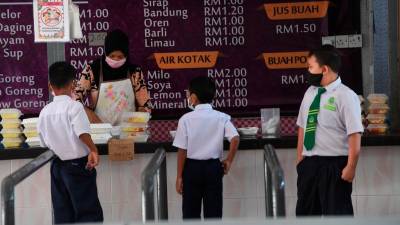THE Education and Health ministries recently banned 12 categories of food and drink from school canteens – everything from candies, chocolates, nuggets to instant noodles and sugary iced drinks.
On paper, it looks like a bold step to curb childhood obesity and promote healthier eating. As a parent of a Year Four boy, I welcome the intent. But here’s the truth every Malaysian parent knows: banning junk is the easy part.
The hard part is getting children to eat wholesome food without groaning, sulking or sneakily trading carrot sticks for keropok at recess.
The lunchbox reality
My mornings are a juggling act familiar to thousands of parents. It’s 6.30am, and I am packing a lunchbox while negotiating with my nine-year-old food critic.
Son: “Not fried rice again, Amma.”
Me: “It’s healthy.”
Son: “Healthy is boring.”
He inspects the box like Gordon Ramsay judging contestants.
Sometimes the food goes from “yummy” to “why me?” in 10 minutes, and the apple slices are already turning brown.
Meanwhile, canteen stalls compete to sell food that children will actually buy, which – let’s be honest – often means fried, sweet or salty.
This is where the ministry’s plan hits its first snag. Without subsidies, training and clear monitoring, banning nuggets doesn’t mean children will suddenly start eating spinach; it just means vendors will get creative with labels, children will smuggle in Choki-Choki from home and teachers will be left playing canteen police on top of teaching.
Why bans alone don’t bite
The ministries have their hearts in the right place but enforcement without support risks backfiring.
Fresh fruit costs more than a plate of fried mee goreng. Wholesome meals take longer to prepare. Vendors can’t absorb higher costs, and parents won’t stomach higher prices.
The result? Either boring menus nobody eats or unhealthy food disguised as something else. Call a nugget a “golden soy cube” or slap the label “vitamin water” on sugar syrup – it doesn’t change what it is.
The children know and so do the parents. So, why let policymakers play along?
What needs to happen next
Here is my wishlist for the ministries – and no, it is not just more circulars and PowerPoints.
• Subsidise wholesome food: Fresh fruits, local vegetables and whole grains – make them cheaper for vendors. Otherwise, healthy = costly, and bans = resentment.
• Train canteen makciks: Don’t just ban foods – provide a recipe bank of tested, low-cost and child-friendly meals. Workshops on taste, hygiene and portioning will go further than circulars.
• Steal with pride: In Japan, schools serve fresh, balanced meals every day. Students eat together and help with serving and cleaning so healthy eating is part of daily life. Menus change with the seasons while they teach children to enjoy variety and fresh ingredients.
In Finland, every student gets free, healthy meals. Nutrition is taught in class, so children understand why balanced eating matters, not just what to avoid. This helps healthy habits stick from a young age.
Singapore ensures school canteens follow strict health rules. Vendors are trained and monitored, and national campaigns make healthy meals appealing. Children eat nutritious food that is tasty and accessible.
Malaysia doesn’t need to copy wholesale but we should adapt the principle: healthy food must be fresh, affordable and normalised.
• Educate children: You can ban Coke but unless children understand why, they will smuggle in sachets of 3-in-1 Milo. Children need to know why certain foods are better. Make it part of Science, Bahasa essays and even art projects. If children are invested in, enforcement becomes easier.
• Monitor and adapt: Track food waste, sales patterns and health outcomes. If nobody eats the boiled broccoli, change the recipe – don’t just scold the children.
Let’s be real
Malaysians love food – nasi lemak, teh tarik, not quinoa bowls. Tell a child it is “unhealthy”, and you’ve declared war.
Picture this classic canteen scenario:
Vendor: “Encik, this one bukan nugget… ini sfera protein artisan special-lah.”
Food Inspector: “Aiyo, artisan-ah? Okay-lah.”
Child: “Teacher, I tak beli from canteen… I bawa sendiri from rumah!”
At home, negotiating with my 10-year-old food critic:
Me: “Fried rice with telur dadar, carrot and broccoli.”
Son: “Alamak, carrot and broccoli again?”
Me: “It’s healthy, sayang.”
Son: “Healthy? More like death by green-lah!”
Sometimes the spinach disappears and sometimes it comes back untouched but slip in a piece of chocolate, and suddenly I’m the “best mummy ever”.
Bigger picture
The ban is a start but it cannot stop at outlawing nuggets. Real change means reshaping the food environment so that healthier meals are tasty, affordable and socially normal. That requires funding, training and creativity – not just another laminated list on the canteen wall.
As a parent, I don’t want my child to be a sugar-zombie but I also don’t want him coming home hungry because the only canteen option was plain rice and boiled egg.
Banning the bad is half the job but making the good desirable is the real challenge. Until then, parents like me will keep waging daily battles with our little food critics.
This morning, I won with fried rice – spinach included. Tomorrow, who knows? Maybe I’ll even sneak in a single piece of chocolate, for morale purposes only.
Hashini Kavishtri Kannan is the assistant news editor at theSun. Comments: letters@thesundaily.com
